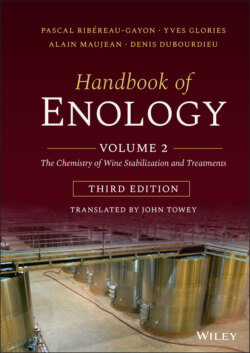Читать книгу Handbook of Enology, Volume 2 - Pascal Ribéreau-Gayon - Страница 21
1.3.2 Volatile Acidity
ОглавлениеVolatile acidity in wine is a highly important physicochemical parameter to be monitored by analysis throughout the winemaking process. Although it is an integral part of total acidity, volatile acidity is clearly considered separately, even if it only represents a small fraction in quantitative terms.
This value has always been, quite justifiably, linked to wine quality. Indeed, when an enologist tastes a wine and decides there is excessive volatile acidity, this unfavorable assessment has a negative effect on the wine's value. This organoleptic characteristic is related to an abnormally high concentration of acetic acid, in particular, as well as a few homologous carboxylic acids. These compounds are distilled when wine is evaporated. Those which, on the contrary, remain in the residue constitute fixed acidity.
Volatile acidity in wine consists of free and salt forms of volatile acids. This explains why the official assay method for volatile acidity, by steam distillation, requires the salt fractions to be rendered free and volatile by acidifying the wine with tartaric acid (approximately 0.5 g per 20 ml). Tartaric acid is stronger than the volatile acids, so it displaces them from their salts.
In France, both total and volatile acidity are usually expressed in grams per liter of sulfuric acid. An appellation d'origine contrôlée (controlled designation of origin) wine is said to be “of commercial quality” if volatile acidity does not exceed 0.9 g/l of H2SO4, i.e. 1.35 g/l expressed as tartaric acid and 1.1 g/l as acetic acid. Acetic acid, the principal component of volatile acidity, is mainly formed during fermentation.
Alcoholic fermentation of grapes normally leads to the formation of 0.2–0.3 g/l (as H2SO4) of volatile acidity in the corresponding wine. The presence of oxygen always promotes the formation of acetic acid. Thus, this acid is formed both at the beginning of alcoholic fermentation and toward the end when the process slows down. In the same way, an increase in volatile acidity of 0.1–0.2 g/l (as H2SO4) is observed during malolactic fermentation. Work by Chauvet and Brechot (1982) established that acetic acid is formed during malolactic fermentation due to the breakdown of citric acid by lactic acid bacteria.
Abnormally high volatile acidity levels, however, are due to the breakdown of residual sugars, tartaric acid, and glycerol by anaerobic lactic acid bacteria. Aerobic acetic acid bacteria also produce acetic acid by oxidizing ethanol.
Finally, acescence in wine is linked to the presence of ethyl acetate, i.e. the ethyl ester of acetic acid, formed by the metabolism of aerobic acetic acid bacteria (Section 2.5.1).
